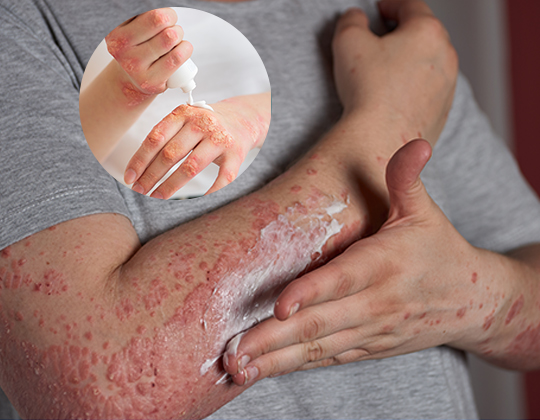Call :

Psoriasis is a long-lasting, noncontagious autoimmune disease characterized by skin. These areas are red, pink, or purple, dry, itchy, and scaly. Psoriasis varies in severity from small localized patches to complete body coverage. Injury to the skin can trigger psoriatic skin changes at that spot, which is known as the Koebner phenomenon.
The five main types of psoriasis are plaque, guttate, inverse, pustular, and erythrodermic. Plaque psoriasis, also known as psoriasis vulgaris, makes up about 90% of cases.[4] It typically presents as red patches with white scales on top.[4] Areas of the body most commonly affected are the back of the forearms, shins, navel area, and scalp.[4] Guttate psoriasis has drop-shaped lesions.[5] Pustular psoriasis presents as small, non-infectious, pus-filled blisters. Inverse psoriasis forms red patches in skin folds. Erythrodermic psoriasis occurs when the
rash becomes very widespread, and can develop from any of the other types. Fingernails and toenails are affected in most people with psoriasis at some point in time. This may include pits in the nails or changes in nail colour.
Psoriasis is generally thought to be a genetic disease that is triggered by environmental factors. Symptoms often worsen during winter and with certain medications, such as beta blockers or NSAIDs. Infections and psychological stress can also play a role. The underlying mechanism involves the immune system reacting to skin cells. Diagnosis is typically based on the signs and symptoms.
There is no known cure for psoriasis, but various treatments can help control the symptoms. These treatments include steroid creams, vitamin D3 cream, ultraviolet light, immunosuppressive drugs, such as methotrexate, and biologic therapies targeting specific immunologic pathways. About 75% of skin involvement improves with creams alone. The disease affects 2–4% of the population. Men and women are affected with equal frequency. The disease may begin at any age, but typically starts in adulthood. Psoriasis is associated with an increased risk of psoriatic arthritis, lymphomas, cardiovascular disease, Crohn's disease, and depression. Psoriatic arthritis affects up to 30% of individuals with psoriasis.
A beautiful fact about the science of Ayurveda is that it does not just look at physiological symptoms to diagnose a condition, but it also brings in the mind in the process of diagnosis and healing. This is the reason why alternative treatments like Ayurveda are so successful in dealing with psychosomatic disorders that affect millions of Americans.
Ayurveda addresses psoriasis as Kithibha, a disorder caused by toxins in the blood that have root in emotional trauma and unresolved emotional matters, inappropriate diet, and chronic stress. Psoriasis can also reflect an imbalance in vata and kapha doshas. Vata vitiation causes the dryness, pain and scales, and pitta imbalance is responsible for the inflammation, burning and itching sensation. Ayurveda looks at purifying the blood and balancing the doshas through specific targeted therapies individualized for each patient since each psoriasis patient is unique in her/her diagnosis, symptoms, and triggers. For More Information write to: Zivik Biosciences.
Copyright © 2023. All right reserved. Zivik Biosciences

